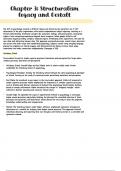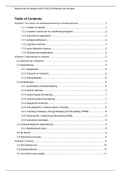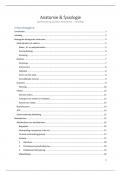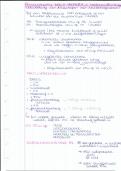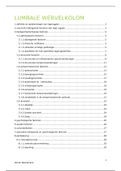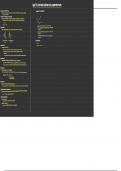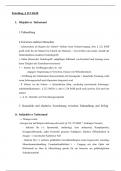Chapter 3: Structuralism
legacy and Gestalt
The shift in psychology towards a different theory was driven by the systematic use of self-
observation. In the past, experiments often lacked comprehensive subject reporting, resulting in a
limited understanding. Traditional concepts like sensations, feelings, and presentations constrained
subjects from recognizing experiences beyond these categories. When people skilled in self-
observation began providing complete, unbiased reports immediately after experiments, the need for
new ideas and definitions became clear. This approach uncovered processes, mental states, directions,
and actions that didn't align with established psychology. Subjects started using everyday language,
placing less emphasis on mental imagery, and demonstrated the ability to know, think, judge,
understand, and make connections independently (=language of life).
Würzburg School
Structuralism focused on simple cognitive processes (sensations and perception) but forgot about
complex processes (sensation and perception)
• Würzburg School: Oswald Külpe and Karl Marbe, both of whom studied under Wundt,
established the Würzburg School of psychology
• Psychological Paradigm: Initially, the Würzburg School followed the same psychological paradigm
as Wundt, focusing on the study of mental processes, particularly sensations and perception
• Karl Marbe: He introduced a new aspect to the structuralist approach. While still interested in
simple cognitive processes, Marbe emphasized the importance of complex cognitive processes
such as thinking and abstract reasoning. He believed that psychology should explore thinking
based on sensory information. Marbe introduced the concept of "imageless thought," which
referred to abstract reasoning and conscious mental states.
• Oswald Külpe: He expanded the scope of experimental methods in psychology to investigate
higher mental processes, particularly thinking. He advocated for controlled induction of these
processes and systematic self-observation, which allowed for the study of areas like judgment,
knowledge, understanding, and interpretation.
• Method: The Würzburg School, under Külpe's influence, emphasized systematic introspective
observation as a method for studying these higher mental processes. This approach involved
individuals observing and reporting their own thoughts and mental activities in a controlled and
systematic manner.
, In summary, the Würzburg School, influenced by Külpe and Marbe, built upon Wundt's work by
broadening the scope of psychological research to include the study of complex cognitive
processes such as abstract reasoning and introduced systematic introspective observation as a
method for studying these processes.
Through retrospective analysis of the consciousness process, we gain insights into discerning the
constituent elements of that consciousness.
A student preparing for a final exam in a biology course.
• Plans: Plans refer to guidelines used in problem-solving through thought processes. These
plans can change based on instructions given to participants. They are associated with the
"function" of thought, indicating the direction and motivation of thinking, rather than the
specific "content" of thoughts.
A study strategy or approach. For example, the student decides to use a study schedule that
involves reviewing one chapter of the textbook each day, creating flashcards for key terms, and
practicing sample questions from previous quizzes.
• Goals: Goals are represented as a gap or problem that needs to be solved. A plan is employed
to fill in this gap or achieve the goal. Goals are central to the thought process and serve as
the driving force for problem-solving.
The ultimate objective of performing well on the final exam and earning a high grade
• Schemas: Schemas represent an individual's thought process when approaching problem-
solving. They are essentially the mental representation of a problem. A problem is defined as
a set of data with a gap that requires filling. Solutions to problems are found within the
available data. The predisposition to solve problems arises from the initiation of strategies
aimed at closing the gap or achieving the goal.
The student's mental framework for studying biology. It includes their understanding of the
course content, their prior knowledge, and their preferred study methods. The schema guides how
they approach studying and problem-solving related to biology topics.
In summary, the role of plans, goals, and schemas in the consciousness process, particularly in
problem-solving. Plans provide guidelines for thought, goals represent the problems to be solved,
and schemas are the mental representations of the problem-solving process. The process involves
using plans to bridge the gap and achieve the goals defined by the schemas.
legacy and Gestalt
The shift in psychology towards a different theory was driven by the systematic use of self-
observation. In the past, experiments often lacked comprehensive subject reporting, resulting in a
limited understanding. Traditional concepts like sensations, feelings, and presentations constrained
subjects from recognizing experiences beyond these categories. When people skilled in self-
observation began providing complete, unbiased reports immediately after experiments, the need for
new ideas and definitions became clear. This approach uncovered processes, mental states, directions,
and actions that didn't align with established psychology. Subjects started using everyday language,
placing less emphasis on mental imagery, and demonstrated the ability to know, think, judge,
understand, and make connections independently (=language of life).
Würzburg School
Structuralism focused on simple cognitive processes (sensations and perception) but forgot about
complex processes (sensation and perception)
• Würzburg School: Oswald Külpe and Karl Marbe, both of whom studied under Wundt,
established the Würzburg School of psychology
• Psychological Paradigm: Initially, the Würzburg School followed the same psychological paradigm
as Wundt, focusing on the study of mental processes, particularly sensations and perception
• Karl Marbe: He introduced a new aspect to the structuralist approach. While still interested in
simple cognitive processes, Marbe emphasized the importance of complex cognitive processes
such as thinking and abstract reasoning. He believed that psychology should explore thinking
based on sensory information. Marbe introduced the concept of "imageless thought," which
referred to abstract reasoning and conscious mental states.
• Oswald Külpe: He expanded the scope of experimental methods in psychology to investigate
higher mental processes, particularly thinking. He advocated for controlled induction of these
processes and systematic self-observation, which allowed for the study of areas like judgment,
knowledge, understanding, and interpretation.
• Method: The Würzburg School, under Külpe's influence, emphasized systematic introspective
observation as a method for studying these higher mental processes. This approach involved
individuals observing and reporting their own thoughts and mental activities in a controlled and
systematic manner.
, In summary, the Würzburg School, influenced by Külpe and Marbe, built upon Wundt's work by
broadening the scope of psychological research to include the study of complex cognitive
processes such as abstract reasoning and introduced systematic introspective observation as a
method for studying these processes.
Through retrospective analysis of the consciousness process, we gain insights into discerning the
constituent elements of that consciousness.
A student preparing for a final exam in a biology course.
• Plans: Plans refer to guidelines used in problem-solving through thought processes. These
plans can change based on instructions given to participants. They are associated with the
"function" of thought, indicating the direction and motivation of thinking, rather than the
specific "content" of thoughts.
A study strategy or approach. For example, the student decides to use a study schedule that
involves reviewing one chapter of the textbook each day, creating flashcards for key terms, and
practicing sample questions from previous quizzes.
• Goals: Goals are represented as a gap or problem that needs to be solved. A plan is employed
to fill in this gap or achieve the goal. Goals are central to the thought process and serve as
the driving force for problem-solving.
The ultimate objective of performing well on the final exam and earning a high grade
• Schemas: Schemas represent an individual's thought process when approaching problem-
solving. They are essentially the mental representation of a problem. A problem is defined as
a set of data with a gap that requires filling. Solutions to problems are found within the
available data. The predisposition to solve problems arises from the initiation of strategies
aimed at closing the gap or achieving the goal.
The student's mental framework for studying biology. It includes their understanding of the
course content, their prior knowledge, and their preferred study methods. The schema guides how
they approach studying and problem-solving related to biology topics.
In summary, the role of plans, goals, and schemas in the consciousness process, particularly in
problem-solving. Plans provide guidelines for thought, goals represent the problems to be solved,
and schemas are the mental representations of the problem-solving process. The process involves
using plans to bridge the gap and achieve the goals defined by the schemas.

